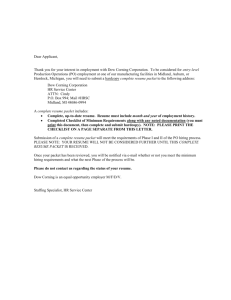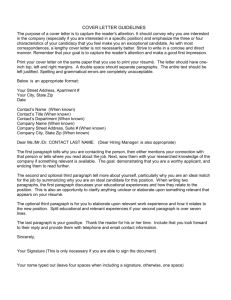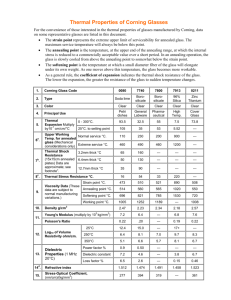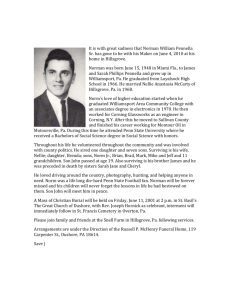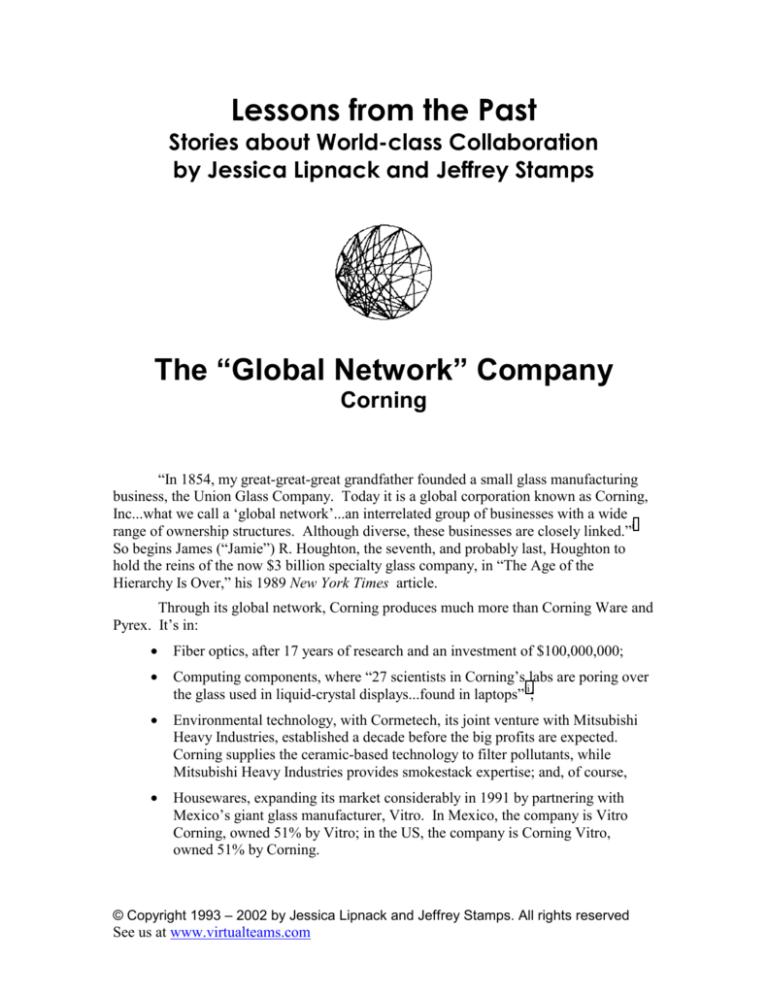
Lessons from the Past
Stories about World-class Collaboration
by Jessica Lipnack and Jeffrey Stamps
The “Global Network” Company
Corning
“In 1854, my great-great-great grandfather founded a small glass manufacturing
business, the Union Glass Company. Today it is a global corporation known as Corning,
Inc...what we call a ‘global network’...an interrelated group of businesses with a wide
range of ownership structures. Although diverse, these businesses are closely linked.”i
So begins James (“Jamie”) R. Houghton, the seventh, and probably last, Houghton to
hold the reins of the now $3 billion specialty glass company, in “The Age of the
Hierarchy Is Over,” his 1989 New York Times article.
Through its global network, Corning produces much more than Corning Ware and
Pyrex. It’s in:
•
Fiber optics, after 17 years of research and an investment of $100,000,000;
•
Computing components, where “27 scientists in Corning’s labs are poring over
the glass used in liquid-crystal displays...found in laptops”ii;
•
Environmental technology, with Cormetech, its joint venture with Mitsubishi
Heavy Industries, established a decade before the big profits are expected.
Corning supplies the ceramic-based technology to filter pollutants, while
Mitsubishi Heavy Industries provides smokestack expertise; and, of course,
•
Housewares, expanding its market considerably in 1991 by partnering with
Mexico’s giant glass manufacturer, Vitro. In Mexico, the company is Vitro
Corning, owned 51% by Vitro; in the US, the company is Corning Vitro,
owned 51% by Corning.
© Copyright 1993 – 2002 by Jessica Lipnack and Jeffrey Stamps. All rights reserved
See us at www.virtualteams.com
Great Collaboration Stories - Corning
2
Until controversy hits one of its partnerships in 1992, the company enjoys
excellent press since 1983 when Jamie takes charge from his older brother Amory, Jr.
(who goes on to become a Republican US Congressman). Business Week’s May 13,
1991, cover story is “Corning’s Class Act: How Jamie Houghton Reinvented the
Company.”iii The “reinvention” prompts not only good press, but also good results.
Reversing three years of steady decline and a 70% dependence on slow-growth
businesses, return on equity climbs from 7.3% in 1983 to 16.3% in 1990. Stock value of
the company (incorporated just before the Civil War) increases 36% in the same period.
Analysts predict earnings likely to grow 20% annually with good market share in strong
growth businesses.
Corning’s is not just a remarkable story of external adventures. It is also a tale of
how a nearly 150-year-old company undertakes a 10-year internal effort to transform
itself into a 21st century corporation. It does so with boundary crossing teamnets.
Corning’s Internal Drive for Quality
Jamie Houghton recalls walking into a “dreary” Rochester, New York, hotel
function room in October, 1983, his first year of office. “Corning plans to spend $5
million on a ‘total quality program,’” he tells his top managers. No one is interested. “It
went over like a bomb They thought it was the flavor of the month,” he says later.iv
Undaunted, he barrels ahead with his vision to turn Corning into a quality enterprise. He
appoints Corning’s first director of quality. He goes on the road, carrying his vision to
over 50 company and partner sites. He requires that everyone goes through a two-day
quality seminar.
At Corning, quality means “meeting and exceeding customer requirements.”
Delivering the keynote address (appropriately titled “Quality: Beyond the Corporate
Walls”) at the Economic Club of Detroit in October, 1990, Houghton says, “Quality is
more than a business process; it’s an ethical behavior system... Quality implies
empowerment of all people at all levels in an organization. The old pyramid structure is
flattening out with power spreading downward and outward through employee quality
teams.”
Houghton is not exaggerating:
•
Corning people participate in quality circles, the small group management
process that began on the shop floor in Japan in the early 1960s.
•
Corning has hundreds of cross-functional teams in its factories and businesses,
with people from many parts of the organization working together “spotting
trouble and fixing it at the source.”
•
At its “Factory of the Future” in Blacksburg, Virginia, Corning runs 24-hours a
day, 7 days a week, self-supervised by “high-performance work teams,” with
“mentor networks” guiding new hires.
Corning also partners with the labor unions. The company and the union jointly
work to increase employee participation in worker teams. These teams determine job
schedules and participate in factory design. When a molten-metal filter production plant
moves from an older facility to Erwin, NY, union workers design it with open spaces,
Great Collaboration Stories - Corning
3
sound dampening ceilings, numerous windows, and a production line that keeps everyone
on a team within earshot of one other. They redesign the organization, not only the
technology: 47 job classifications fold into one, employees rotate jobs weekly, and
salaries rise when people learn new skills. The defect rate dives from 10,000 per million
to 3 per million, with virtually no customer returns. At Corning, quality works.
In 1987, Houghton launches a new crusade: he appoints two company wide
teams to address workforce diversity. Corning, the tiny upstate New York town, also
benefits. The company invests in the community, addressing economic, racial, and
quality of life issues: it buys and rehabilitates properties; it builds a hotel, museum and
library; and, it arranges for the local cable station to carry black oriented programming.
Corning understands the essence of quality: a focus on people.
Corning and its Partners
Corning is not new to the joint venture business. It is 1924 when Corning first
takes advantage of complementary product development with another company, making
cartons for glass products. This practice of Corning and its partner each contributing its
expertise will be echoed for the next 75 years in some 60 ventures. These partnerships,
says Houghton, contribute about half of Corning’s earnings, which he believes to be
“unique among Fortune 500 companies.” Some are really micro-joint ventures such as
Corning’s partnerships with Genentech in enzymes and tiny PCO, Inc., in optics.
Corning’s partners include some newer ones—Siemens of Germany, Ciba of
Switzerland, Samsung of South Korea—and some quite old—like Asahi Glass of Japan.
Amazingly, even though the Japanese partner and Corning did not communicate during
World War II, Asahi Glass kept meticulous records and presented Corning with its
earnings after the war was over.
During the same war, a handshake between Jamie Houghton’s father and Dr.
Willard Dow in 1941 established perhaps the most famous of the partnerships: Dow
Corning to produce silicones. Dow Corning illustrates both the profits and the peril of
partnerships. In 1991, Dow Corning’s $2 billion in revenues contributes 25% of
Corning’s $316.8 million earningsv. In 1992, Dow Corning, which produces 5000
specialty chemicals ranging from the sealants used on the O-rings of the Space Shuttle to
Silly Putty, is on the front page because of silicone breast implants. Potential lawsuits
could exceed $1 billion or more in liabilities.
In the long view, a vulnerable partnership will not deter Corning from its network
strategy. In networks, the parts do not necessarily conform to the structure of the whole.
Nor is Corning likely to alter its basic philosophy that respects the autonomy of both its
partners and the joint venture spinoffs. Autonomous partners, for better or worse,
comprise networks. Indeed, it is the real autonomy of Dow Corning from its founding
parents that provides the break wall against the storm of suits that follows the ban on
silicone implants.
Despite mistakes, Corning is extremely successful in its joint ventures. “Corning
has the critical ability to treat its partners as true equals, to see their interests and respond
to them,”vi writes Jordan Lewis, author of Partnerships for Profit.
Great Collaboration Stories - Corning
4
As above, so below. The treatment of both corporate partners and employees as
equals springs from the same culture and philosophy. “We have found that the successful
operation of a global management network requires a new mind-set,” Houghton writes.
“A network is egalitarian...[with] no parent company. A corporate staff is no more or
less important than a line organization group... [B]eing part of a joint venture is just as
important as working at the hub of the network.”vii
Houghton calls Corning “a work in progress.” It is a rare long term experiment in
conscious transformation from a traditional American hierarchy to a more networked
form of management at every level. Is the Corning way right for every company?
Probably not. Yet other companies use these and similar ideas in different ways to
improve their businesses.
Every business needs to adapt to change. By knowing what some companies have
tried, you will get a clearer idea of what might work for you.
At the nexus of business boundaries, internal and external, is the enterprise.
Great Collaboration Stories - Corning
5
iJames
R. Houghton. “The Age of the Hierarchy Is Over.” The New York Times, Sept.
24, 1989, Forum section.
iiKeith
1991.
H. Hammonds. “Corning’s Class Act,” Cover Story, Business Week, May 13,
iiiBW
ivBusiness
vBill
viBW
Week article
Vlasic. “Dow Corning’s Billion-Dollar Crisis.” The Detroit News, March 8, 1992.
cover
viiNYT
9/24/89



